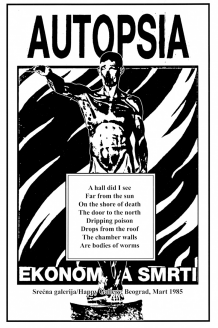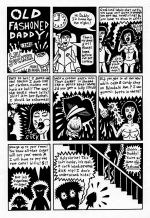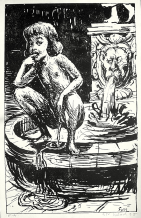| Revista Umělec 2009/2 >> Rapidité! Accelerating Modesof Subjectivation in Proto-Postfordism | Lista de todas las ediciones | ||||||||||||
|
|||||||||||||
Rapidité! Accelerating Modesof Subjectivation in Proto-PostfordismRevista Umělec 2009/201.02.2009 Gerald Raunig | time | en cs de |
|||||||||||||
|
Jacques Tati, as this piece will explore, is an early participant of the proto-postfordist avant garde in the middle of the 20th century. Film critics often misunderstand Tati’s work as a criticism of civilization and a denunciation of the unreasonable demand of modernism. They especially misinterpreted Tati’s first feature film, Jour de Fête, in this way, due to its idyllic framework (and, above all, its ludicrous synchronisations). Considering, however, the sequence of L’école des facteurs (The School for Postmen, 1947) and Jour de Fête (The Day of the Party, 1949), in which almost all the scenes of the “school of postmen” were included, there is one thing that becomes apparent: Tati’s first feature-length movie can by no means qualify as a hymn to pre-modernism and a return to rural country life. The barely fifteen minute long sketch-sequence L’école des facteurs is more than a mere preliminary study. Within the short movie, the crunch that Tati wants to get at arises more evidently. As a pure parody of the military-style disciplining of postmen and the fragmentation and rationalization not only of their working day, but also of every detail of movement in the Fordist framework of labor, the School for Postmen shines with mini-attractions that thwart this regime. These extremely physical tricks especially on bicycles, which are typical for Tati, follow one another in quick succession in L’école des facteurs; in Jour de Fête they are slightly hidden by the many details of village life and the seemingly contemplative frame of the plot. Where L’école des facteurs derides the state-form, the institutional stratification of the post-apparatus, Jour de Fête elaborates, with the same sketches, the community-form above all and develops an attitude of resistance out of it.
The first feature-length film Tati wrote and produced ends, on the surface, quite quaintly and pettily bourgeois, yet it unfolds its strength as burlesque, which can be understood from a contemporary perspective as less anti-modern/anti-fordist than proto-postfordist. During a fair, the carnies show a newsreel about the brand new refurbishment methods within the U.S. postal system. A sorting machine, airmail, and a postal helicopter tend to the optimal execution of the Taylorist motto "time is money." The American mailmen mixed up in pictures of reckless motorbike stunts turn out to be the pioneers of modernism. François, a country postman cast by Tati himself, sees these pictures and is inspired by a new zeitgeist. From then on his motto is: "rapidité-speed!” and he obsessively wants to modernize his simple job. Jour de Fête gets completely prophetic in scenes where François—triggered by the abstract machine of the film neewsreel—breaches the tranquility of his rural community and lets the labour division of the state postal apparatus implode. On the same evening of the projection of the newsreel, Tati lets his protagonist (i.e. himself)—intoxicated by the festival, the alcohol, and the onset of the effect of the pictures on the possibilities of the modern post—merge, in incredible tricks with his bike, to a machine. The following day, he mutates into "Monsieur Postman," while the motto rapidité becomes a metaphor for the modernization of the country postal system. Watching the actions of "Monsieur Postman“ a bit more closely, one may recognize that he leaves decades behind him at an incredible pace and skips the ones ahead of him, just like the Fordist acceleration did with the help of industrialization and labour division. His mutation corresponds not only with fetching introduction of the city modernisation mechanisms, but what’s more, it is in all its machinery subjectivation and precariousness a component of anticipating the postfordist mode of production. François drives faster and more deftly with his bicycle. He can accomplish the figures of American motorcycle stunts—driving through fire, jumbling the traffic organization and several times rolling up the field of a roadrunner with a burst of speed. In the end, his bike rides on its own, breaks away from the forced Fordist community, and then, casually leaning against the tavern wall, waits for its dangling associate. Eventually Monsieur Postman packs all the neccessary utensils so that he himself could turn into a post office. No, he does not only tear away from the village community; his frenzied escape from the community and the state apparatus is at the same time an invention: the invention of a new office in motion. Trying all the time to push the acceleration of the motion and work to its greatest potential, the bicycle acrobat attaches himself to a lorry, he spreads on its back turned plank letters, stamps, seals and he opens his mobile post office. As he merges with his capital goods, he becomes a self-entrepeneur, a post office himself—similar to the monomanic production machine Tati, who was struggling against the extreme labour division in the film genre. Towards the end, the speed-driven man falls into a river with his bicycle and is carried out to safety by a bent old woman meandering through the whole film with her goat as an allegory of rural life. The idyllic end, however, is deceptive; in the last scene, a small boy in postal uniform runs after the showman-vehicle—the rapidité virus is unleashed on the world. Twenty years later the epidemic starts to spread around all of Europe. "It was for that, which dawns as the future that the term Postfordism is invented—it is a linguistic afterwards, which seems to stand obstinately at the exit of the past and only very shyly knocks on the door of the future, because it no longer has its past home." Thus Hans-Christian Dany’s cultural history of amphetamines describes the passage from Fordism to Post-Fordism, which Tati seems to anticipate several times. And as the “linguistic afterwards” stubbornly (and at the same time curiously) looks round the corner towards the future, the more diverse the descriptions for the ongoing societal transformations since the late 1960’s: post-industrial society, society of service, society of information, knowledge economy or cognitive capitalism. It does not matter what concept comes to the foreground—acceleration, tempo, speed of the streams crossing it shape the quality of the “futurous” whose threshold we already passed through long ago. Dany’s book is not called Speed in vain. The societal transformations are also vital for the use and function of the cheap drug, which in slang language is described by its users as “speed”. But in Post-Fordist capitalism, it does not imply any more the ambivalent acceleration as a fitmaker for the daily working routine and as a resistive medium of new subcultures. In an incredible process of disambiguation, it is to be found just on the affirmative part, but now as a component of the care for oneself. The controlled ecstasy becomes more and more a part of a well-ordered attitude towards oneself, where ecstasy and broadening of consciousness are calculated as components of effectiveness. In the neo-liberal governmental ways of subjectivation, the drug family “speed” becomes one of many ingredients of a generalized way of self-government. In the times of acceleration, the cipher “speed” concerns not only this one component of drug usage, but above all the realms of production and reproduction. It also concerns the realms of the cognitive, the communicative, and the affective. Dany describes this through the example of another Proto-Postfordist avant-garde, which begins twenty years after Tati—Andy Warhol’s Factory. In this “factory”—similar to the political context of fabbrica diffusa, which was conceptually created at the beginning of the 1970s by the Italian operaists—time and space of its subjects diffuse. As “pioneers of the new type of labor,” they can do without a stable, collective working place as well as without the ordered Fordist timing. They do not create things, but atmospheres: “The majority of the present ones deals with activities, which are not actually recognized as work and mostly look like its opposite, so that some consider it a party.” This new mode of enslavement is not any more based on the division of labor and free time, performance and leisure, factory and home, sobriety and drug consumption, but right on the blur of the previously neatly divided areas. Speed arrives from the more or less chosen marginality at the center of Postfordist production, and “in this addicted society based on addiction” it spreads far beyond the drug users as an addiction to all kinds of acceleration—mainly as addiction to attachment to communication and information technologies. And into this addictive attachment the components of the devices, which were once described as machines, and our own mechanistic subjectivations merge together. The way that we assume the functionality of technological devices that we manipulate and that manipulate us, so do the devices take over our skills, our technique, our knowledge. It seems as if we have gone one step further in our becoming machines, from the Fordist-industrial interchange with industrial facilities to Postfordist-informational interchange with computers. And, therefore, like the idea of the 19th century that the machines represented something like our lengthened arms was reductive, so even more the simple idea that a computer may be the prosthesis of our brain. Instead of a one-sided upgrade of a human body, a simple enhancement of a human via machine, it was and is always about a flow, about mechanistic streams, which carry at the same time things, people, and socialities. When these streams, fuelled by a mechanistic desire, now tendentially accelerate into the infinite, fatal consequences for living and working conditions emerge from this. Some of the worse excesses are the outsourcings of material, filthy jobs to the global peripheries, recent, intertwined forms of sexist and racist exploitation, or new pathologies of the full-speed-subjects. Yet, like production, the mechanistic desire also has a revolutionary side. Jacques Tati suggests an offensive strategy of the accelerated singularization. Monsieur Postman embodies a possible form of resistance in a way. Simply turning off the machines, breaking them in a Luddite manner, or throwing the proverbial wrench into the machines does not help against the new subjectivations or the new forms of atomizing individualization. The established models of dealing with sociality are just as little help: the rigid fragmentation of the state apparatus becomes as obsolete as the return to the community, since the dichotomy of individual and community is not relevant in this dispositive. Against this background, the yearning for a state-distributing social space and for the community closing itself off loses its meaning, and we have to ask ourselves, “What are the machines in which singularities could become united instead of stuck in the identity-containers of the community and fragmented by the state apparatus? Of what sort is this new bond, which cannot be understood as homogenizing coherence? Where does this unbounded bond emerge, which is actualized as interchange and unification, bound by the lack of a bond?”
01.02.2009
Artículos recomendados
|
|||||||||||||
|
04.02.2020 10:17
Letošní 50. ročník Art Basel přilákal celkem 93 000 návštěvníků a sběratelů z 80 zemí světa. 290 prémiových galerií představilo umělecká díla od počátku 20. století až po současnost. Hlavní sektor přehlídky, tradičně v prvním patře výstavního prostoru, představil 232 předních galerií z celého světa nabízející umění nejvyšší kvality. Veletrh ukázal vzestupný trend prodeje prostřednictvím galerií jak soukromým sbírkám, tak i institucím. Kromě hlavního veletrhu stály za návštěvu i ty přidružené: Volta, Liste a Photo Basel, k tomu doprovodné programy a výstavy v místních institucích, které kvalitou daleko přesahují hranice města tj. Kunsthalle Basel, Kunstmuseum, Tinguely muzeum nebo Fondation Beyeler.
|






































 We Are Rising National Gallery For You! Go to Kyjov by Krásná Lípa no.37.
We Are Rising National Gallery For You! Go to Kyjov by Krásná Lípa no.37.
Comentarios
Actualmente no hay comentariosAgregar nuevo comentario